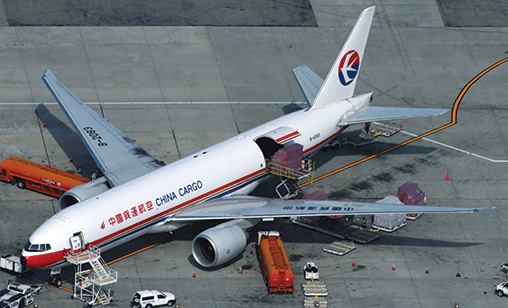Air Cargo
Tariff gloom – and cargo boom?
September 1st 2019
Initial Public Offerings (IPO) logically tend to be in favour when a sector is at its peak or at least performing strongly. Read More » With receding cargo volumes and an escalating U.S.-Sino tariff war, it is an awkward time for China Eastern Airlines’ (CEA) cargo division to pursue one.
Yet amidst overall cargo market negativity, there are pockets of optimism focused on the long-term. All Nippon Airways (ANA) is developing its first intercontinental air cargo market now it has 777 freighters.
 |
Local rival, Japan Airlines (JAL), is starting a block space codeshare between Tokyo and Chicago on freight specialist, Kalitta Air. China Airlines (CAL) is making its debut as a 777 freighter operator with a plan to order six. China Southern Airlines (CSA) has converted orders for two passenger 777-300ERs to freighters, adding to its existing fleet of 12.
While airlines see opportunity, there is another factor in play: Boeing needs to sell 777s. The freight variant of the 777 family has become the better seller as demand naturally wanes for the current 777 passenger aircraft, soon to be outdated by the 777X’s leap in efficiency.
In 2018, the 777 freighter had its best sales year with orders for 45. The 777 freighter has 12 confirmed orders to last July, reported DSM data. There is no competing long-range freight offering from Airbus.
Expectations for the 777 freighter increased in July when Boeing announced it would produce more 777 freighters while it holds off on 777X production due to an engine delay. In 2020, Boeing intends to increase the 777 production rate from 3.5 aircraft a month to five.
ANA expects to focus on freight that cannot easily, or at all, be carried in passenger aircraft bellies including lithium-ion batteries, pharmaceuticals and over-sized items. These categories of freight tend to attract a substantially higher yield, justifying the operating cost of dedicated freighters.
ANA is unique among combination carriers for providing separate statistics for cargo aircraft performance. Its international freighters, in the three months to June 30 and before the 777 freighter started service, generated a yield of JPY35.6 per revenue tonne kilometre, 41% higher than the JPY25.3 average yield for combined passenger belly and freight aircraft cargo. Freighters had a load factor of 64%, eight percentage points higher than belly freight.
So while ANA gains from freighter operations, it has downside protection because its dedicated freight exposure is limited. Only 22% of ANA’s international freight is carried on freighter aircraft. The 777 freighters will increase the share, but passenger aircraft growth in 2020 will swing the statistics back. Belly capacity still rules.
CEA’s developing freight network carried 36% of cargo in freight aircraft. At Cathay Pacific, just under half of cargo is carried on freighters. CEA’s freight arm, China Cargo Airlines (CCA), has six 777 freighters on leases it expects to renew, according to the prospectus of Eastern Air Logistics, which owns CCA.
While there was far greater tonnage in bellies than freighters, the freighters generated 67% more revenue in 2018. That is a strong argument for the prospectus saying an unidentified number of additional 777Fs will be acquired. There is a hint of large ambition since the prospectus also says it will acquire two spare GE90 engines. CCA has one spare engine for six 777Fs.
The additional 777Fs will help Boeing bridge production. After the air framer secured a commitment from CAL, only Asiana Airlines and Singapore Airlines remain as major Asian freight operators that have not re-fleeted.
 |
| 'We’ll probably build more current generation 777s, 777 freighters in that time frame. We have work to do to fill out the specific orders and delivery slots. The market signals are positive' |
| Dennis Muilenburg Boeing CEO |
AC has eight 777Fs and three 747Fs as well as short-haul freighters. CSA has 12 777Fs with two more due for delivery, as well as two 747Fs. CCA’s six 777Fs are supplemented by three 747Fs, making CEA the smallest freight division of China’s “Big Three” carriers despite being located in China’s cargo centre of Shanghai, which handles more cargo than any other mainland city. “The status of Shanghai’s freight hubs can guarantee a leading position in the industry,” the prospectus said in Chinese.
CCA’s 747Fs will evidently stay in service despite their age and two of them having leases expiring soon. In August, CCA signed a five-year maintenance agreement with Lufthansa Technik for the three 747Fs.
CEA’s freight arm will transition from the smallest to the biggest on the Mainland. It is blessed with Shanghai’s geography and is investing in hardware, but the prospectus outlines challenges. Its cargo tonnage only increased by 3% from 2016 to 2017 and the following year recorded almost flat performance. A contraction in cargo on freighters was more than offset by an increase in belly capacity.
Part of the challenge appears to be sophistication, evolving from handling easy but competitive freight types to higher-yielding but more complex cargo. That requires greater end-to-end control, an investment the IPO will enable.
The IPO expects to raise RMB2.4 billion (US$336 million). The single largest use of funds will be US$150 million for constructing the Pudong Integrated Aviation Logistics Center. The balance will be evenly split between upgrading freight stations, the spare engine purchase and then IT and R&D development.
“There is still a gap between the company’s operating scale and multinational companies” in comparison to all-freight operators like FedEx, UPS and DHL, the prospectus said.
Compared with combination carriers like Cathay Pacific and Korean Air and increasingly Qatar Airways, CEA’s cargo business has not branched out. Similar to its passenger business, the airline’s cargo still seems to rely on flows to and from China without fully exploiting transfer opportunities, which can be a hedge if a major trade lane, like China-U.S., has sudden weakness. More available markets can help fill the “dead leg” of freight, the return to Asia that has lower overall demand and a weaker yield.
Reflecting the focus on China, 20% of revenue in 2018 was generated internationally, which grew from 16% in 2016.
The prospectus sounds all the right notes for diversifying cargo types to pursue higher-yielding freight: e-commerce, supply chain products and pharmaceuticals. All of those products more than doubled in volume for CCA from 2016 to 2018, posting faster growth than overall cargo volume. But combined, those three types accounted for only 1% of cargo by tonnage in 2018.
Fresh food products alone accounted for 14%, but those seem weighted towards the less lucrative inbound category, with the prospectus saying such types of fresh food include Chilean cherries and Canadian lobster. They were destined for customers at CCA’s Shanghai home, as well as e-commerce behemoth JD.com.
CCA’s five largest customers generate approximately 20% of revenue. They are Chinese freight forwarders and consolidators, as well as DHL. A top customer in 2017 was Inditex, the Spanish clothing company that includes Zara.
On the cost side, the largest supplier is part-owner CEA, which charges for the big and necessary aircraft maintenance and also the small and less evident costs such as trademark licenses, ULDs and even freighter pilot meals.
The detailed expenses are the result of spinning out freight from the rest of the airline, which other airlines have not contemplated given the intrinsic relationship.
CCA has exclusive rights to market CEA’s belly capacity to 2032. The arrangement is via a complex formula that along with associated related transaction agreements, seems to work in CEA’s favour. CEA’s investment is safeguarded by IPO share caps. But the IPO is not the objective. It is a means to an end.
The planned listing on the Shanghai exchange is less a reflection of anything cargo related and more a statement from CEA that state-owned enterprises can succeed under mixed ownership reform, which CEA chairman, Liu Shaoyong, has personally supported.
Reducing the state’s involvement challenged the conventional wisdom of many government officials. Liu’s initial statements were unusually brazen in China’s buttoned-up world of officialdom and he was the most outspoken, not just of airlines but the whole state-owned sector. It could be argued such reform is not just possible but necessary for survival. The unspoken implication is not about ownership but associated control. CEA wants less government interference.